:: Programme Director: Alexandros Kallegias
:: AA Visiting School Director: Christopher Pierce
:: Tutors: Alexandros Kallegias
Elif Erdine
Dağhan Çam
Charalampos Doukas
Anna Laskari
Eirini Vouliouri
Myrto Maria Barbaris
CIPHER CITY: REVOLUTIONS
The Architectural Association Visiting School in Athens is part of the AI research agenda, investigating design possibilities of architectural modelling via scripting and digital fabricating techniques at large scale models.
AA Athens | Istanbul Visiting School (AI) defines architecture as “an art of super-positioning ideas, architectural principles which are being performed repeatedly”. Its’ foundations lie on combining theory and practice and shared knowledge, with the goal of going beyond individuality and address today’s challenges via dialogue.
On its’ third cycle, AA Athens Visiting School evolved and took upon the task to create a one-to-one scale architectural prototype which demonstrates connectivity, adjustability and interaction. After being Recharged in 2013, Cipher City got equipped to challenge once more the motionless, static built environment by implementing innovative design Revolutions.
Revolutions in design that can transform the inactive built space into an active environment. Revolutions which generate atmospheric ambience through forms that are characterized by motion and real-time reaction to external stimuli. Revolving around interconnectivity on various levels, the program involved separate teams experimenting on different proposals for a kinetic/interactive pathway. After a series of design ideas, the AA Athens VS 2014 concluded with an interactive installation, named Kinetic Haze, which is expressive of a method that involves innovation and combinatory thinking.
This interactive prototype redefines the concept of the architectural pathway. Standing tall at 2.5 meters, 1.2 meters wide and 4.5 meters long, the structure includes a system that has the ability to detect movements. Made of fixed wooden frames and elastic strings that rotate and stretch, the prototype is wired with sensors and actuators. At first, the path appears to be obstructed by the net of strings that run from one side of the structure to the other. The patterning of the woven elastic cords is designed strategically in order to affect the visual perception of a person crossing through the model. Two different sets of panels comprise the final piece; interactive panels and pattern panels. While a person approaches the pathway, the system gets activated by the user’s presence. This acts as the external stimulus that sets the model in different states according to the movement of people. The life-like large-scale prototype bears the behaviour signature of that of primal organism. A complex sort of behaviour which arises out of a multiplicity of relatively simple rules; when there is only a single user the prototype is put in a hostile state, with its flexible muscle-type strings vibrating nervously, blocking the entrance. When a second user appears, the system is reset into a friendly mode allowing for the users to enter its space. The connections rotate and lift gently the elastic cords in order for the two users to walk in and meet. Time and light are also essential in the generation of the desired effects; the system designed to augment the user’s experience of its space. It is by time that the central brain of the structure activates a vivid flickering of lights, thus communicating with its’ users the need to move out. Kinetic Haze acts as an experimental architectural piece that promotes communication of the humans with the structure as well as communication of humans with other humans through the structure. It is the result of the collective work done in less than 5 days by the participants of AA Athens VS 2014. All teams presented their respective design proposals, the basic principles of which were applied in the design and make of the Kinetic Haze.
Katerina Bali, Ismini Epitropou, Efthymia Kasimati, Maria Velaora
Aspired to expand the human perception of space, 4fan team develops frameClouds; an interactive system that allows the user to engage in a play with the built pathway. The frameClouds design follows a tessellation pattern based on the division of triangles. The division pattern is analysed and three strategic intervention points are chosen. These points are used to place air-fans in order to form different fields of interaction with the user. The material system consists of plastic bags which are following the triangulated pattern. Due to their flexible, transparent and unconstrained characteristics, plastic bags are chosen to fulfil the selected grid. They allow light to go through, giving eventually a gradient visual bumping effect. The air-fans are activated by sensing the user’s presence. The bags inflate and deflate and the space is converted from a straight corridor to an experience of refined limits and augmenting duration as the user is drawn to occupy an ever-changing space.
HMN
Hazem Halasa, Dimitra Askouni, Nessma Al Ghoussein
HMN team creates a model that is characterised as Communication through Separation. The concept entails a transformative separation between two people through the structure. A barrier entangling the passageway endeavours to create a kinetic distinction that allows the users through to the other side without the element of visual communication with one another. It plays on the notion of needing another individual without every knowing who they might be or how they might complement them in means other than passing through the structure. It is necessary to keep the users separated in order to heighten this experience of interacting with the unidentified and emphasising the under-rated notion of dependency. The interpretation of the passage manifests itself in a barrier that is slit into horizontal components that deform as the barrier compresses/expands. These deformations would sometime allow the exposure of parts of the users, hinting/teasing them into trying to guess their partner, but never fully revealing one another. The linear division complements the triangular reading of the structure, and also leads the users into using the passage to guide them in a linear direction forward.
Daphne Dimopoulou, Michail Tavladorakis, Christina Bali
Inspired by materiality, Purple_Haze team proposes a system of elastic strings attached onto the pathway’s structure. The placement of the strings is arranged perpendicular to a person’s walk through the pathway, bridging the two opposing sides of the model. As the person enters the path, the prototype shifts from its initial phase to the second phase in order to welcome the user within. Sensing devices transform the dormant architectural piece into an active system; mechanical motors lift up the strings, whose flexible materiality allows them to stretch, thus opening up the path visually. Purple_Haze successfully combines the sophistication behind an Arduino controller with the natural characteristics of stretchy springs to form an interactive architectural model which is driven by the human presence and which is affecting the human perception of space.
The Oscillators
Konstantinos Sfikas, Anastasia Verteouri, Eirini Stolidou, Nikos Kourniatis
Redefining the concept of the architectural pathway, the Oscillators team creates the Nervous Corridor. This interactive passage archetype is divided into a total of five zones; each zone has a different reaction to human presence. According to a person’s distance from the edges of the pathway, the model moves from a relaxed state to a tense state. On its material characteristics, the Oscillators have tested various textile systems; from pleated fabric to allow movement, to elastic transparent membrane and thread-covered triangulated structures. The materiality allows for a more animalistic behaviour when triggered by the motors as it is flexible and has a phase difference on its transformation. Approaching the model’s edges triggers an unpredictable behaviour of the textile system while the central zone is considered as the safe friendly zone. Soft and chaotic oscillation occurs while the user travels from one side of the pathway to the other.
Wave(X)
Maria-Eleni Bali, Zoi-Dafni Arnellou, Catherine Berki
The creative combinatory approach of various material systems together with the intelligent use of the Arduino electronic microcontrollers enables the invention of the human-scale interactive pathway made by Wave(X). The prototype is put in action at the moment a user passes through it by deforming its malleable fabric surface. The physical model consists of wooden fixed beams, wooden moveable vertical elements and a malleable metal net attached on the wooden structure. The interaction takes place by sensing movement within the pathway. Horizontal rails start to move inwards and outwards thus deforming the metal net attached onto them. A perfectly synchronized motion of the rails creates the feeling an enclosure that follows the user walking through the pathway. The smooth movement of the rails followed by the smooth net recreate that of a wave travelling through space and matter accompanying the person moving within.
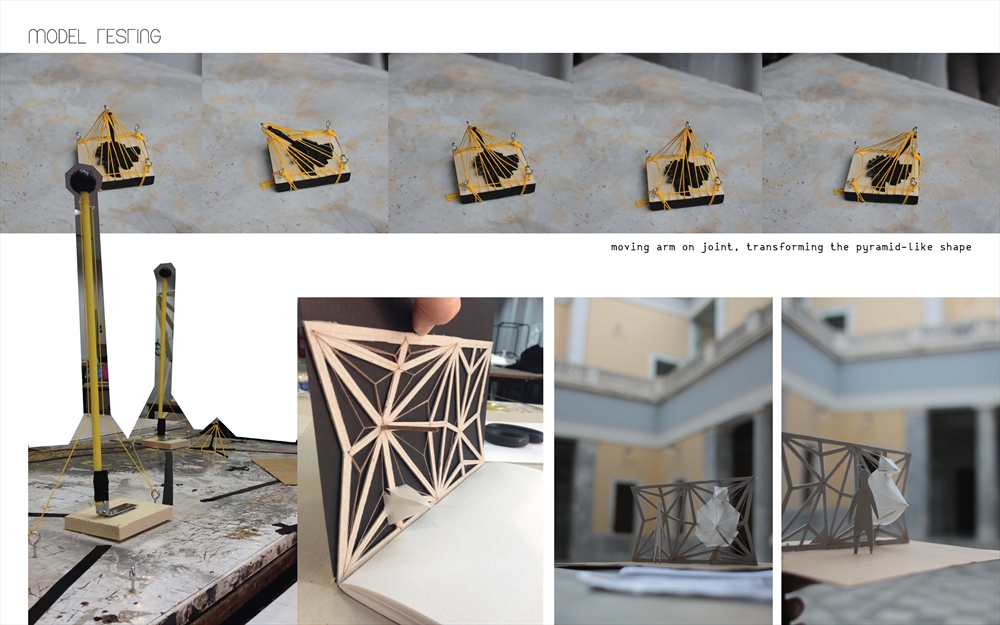 MODEL TESTING BY THE OSCILLATORS
MODEL TESTING BY THE OSCILLATORS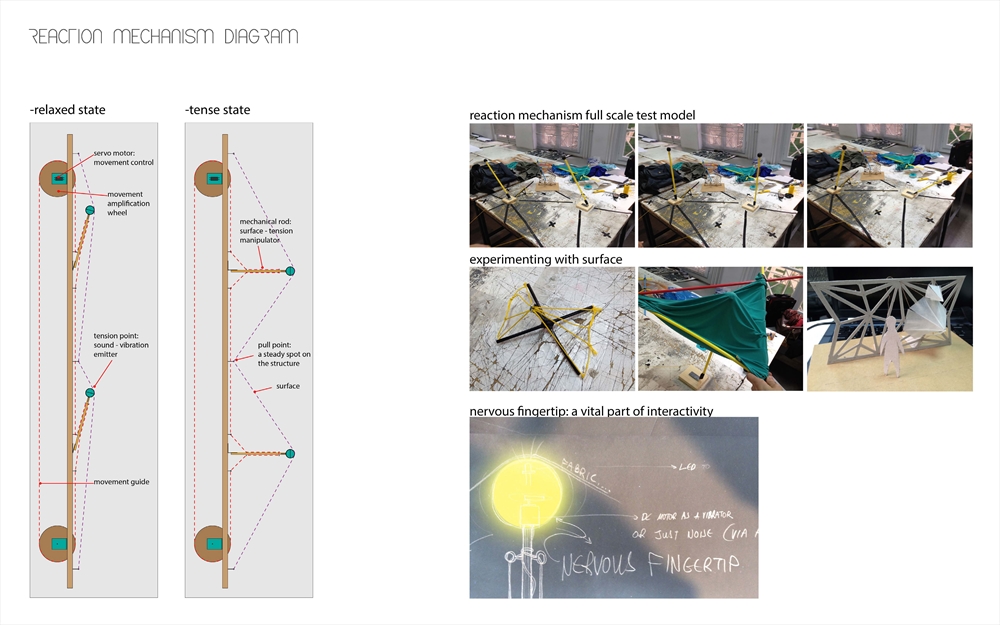 REACTION MECHANISM DIAGRAM BY THE OSCILLATORS
REACTION MECHANISM DIAGRAM BY THE OSCILLATORS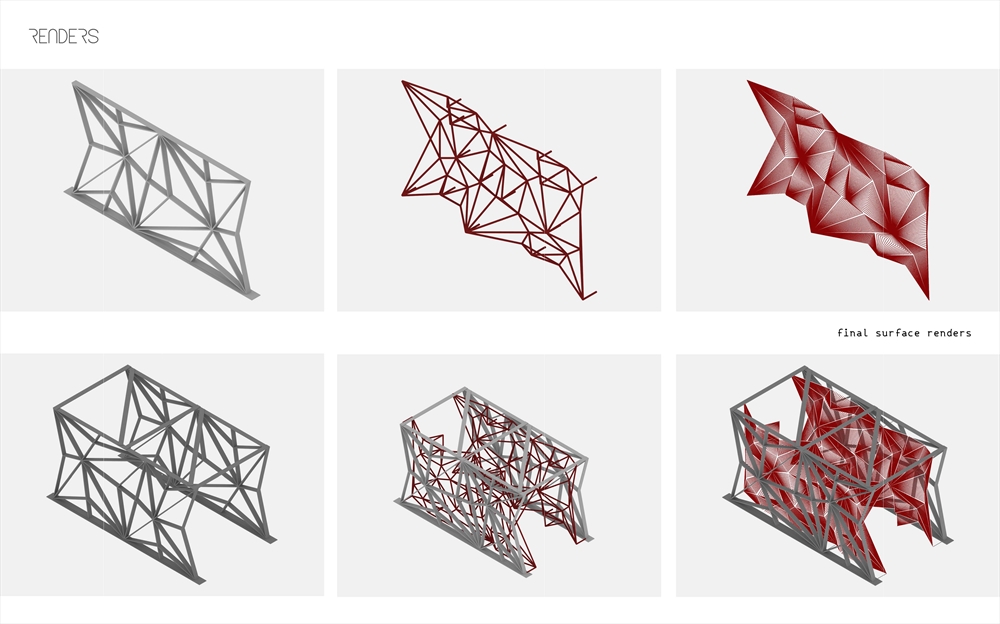 MODEL RENDERINGS BY THE OSCILLATORS
MODEL RENDERINGS BY THE OSCILLATORS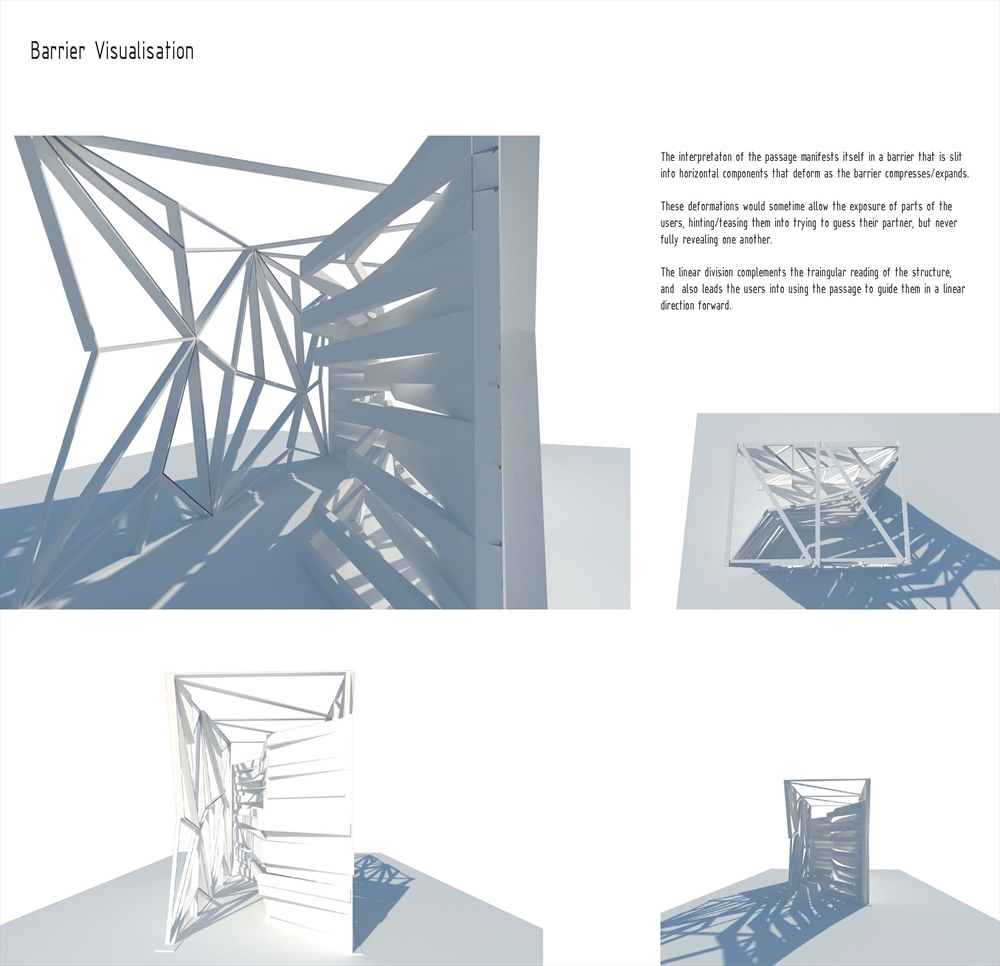 BARRIER VISUALISATION BY HMN
BARRIER VISUALISATION BY HMN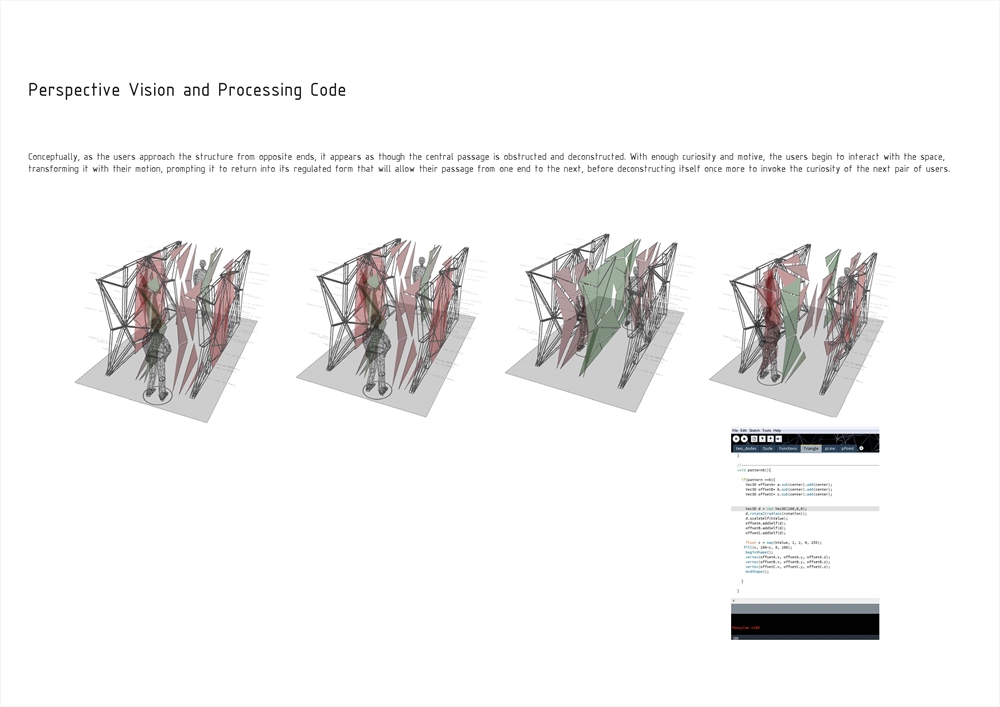 SIMULATION VIA PROCESSING CODE BY HMN
SIMULATION VIA PROCESSING CODE BY HMN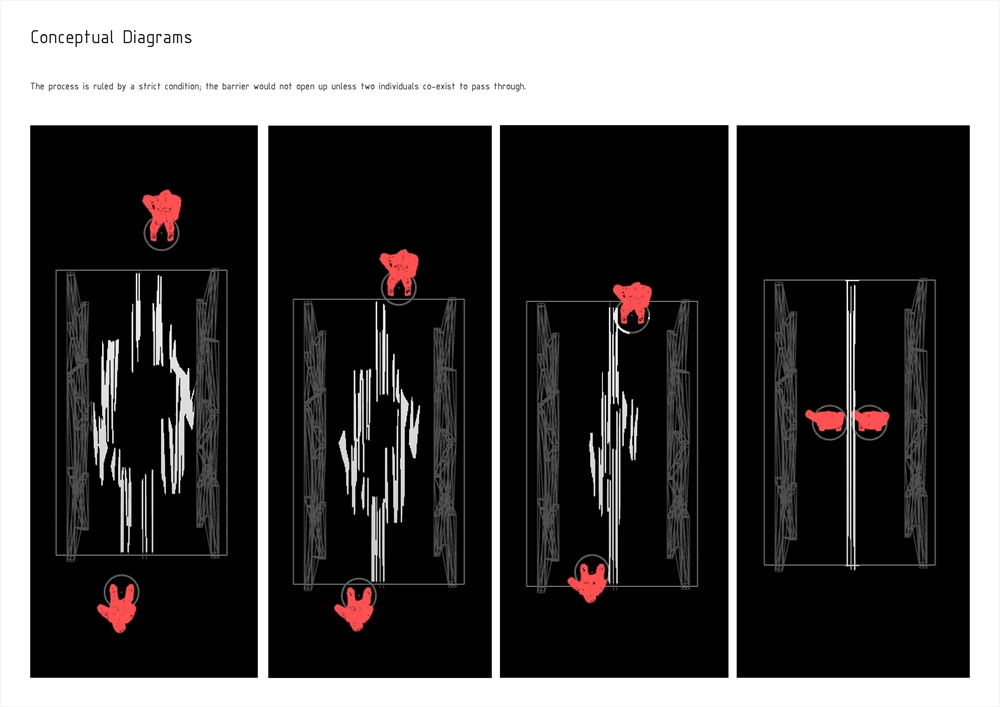 CONCEPTUAL DIAGRAMS BY HMN
CONCEPTUAL DIAGRAMS BY HMN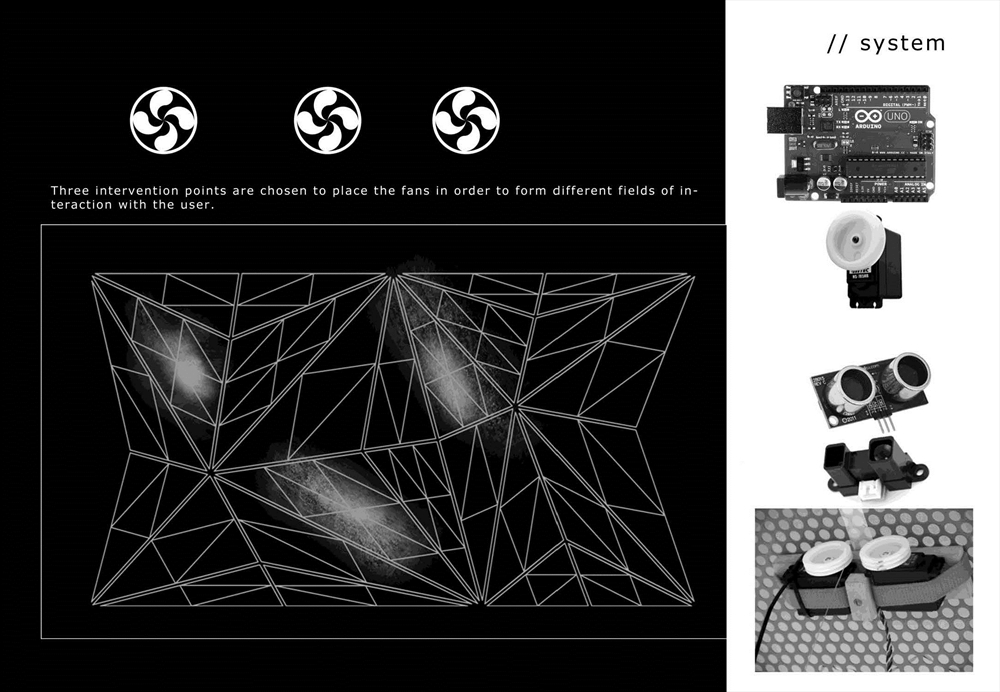 SYSTEM?S DIAGRAM BY 4FAN
SYSTEM?S DIAGRAM BY 4FAN CONCEPT APPLIED IN 1:1 SCALE BY 4FAN
CONCEPT APPLIED IN 1:1 SCALE BY 4FAN DIGITAL SIMULATION OF THE INTERACTIVE/KINETIC ARCHETYPE -IMAGE BY: ALEXANDROS KALLEGIAS
DIGITAL SIMULATION OF THE INTERACTIVE/KINETIC ARCHETYPE -IMAGE BY: ALEXANDROS KALLEGIAS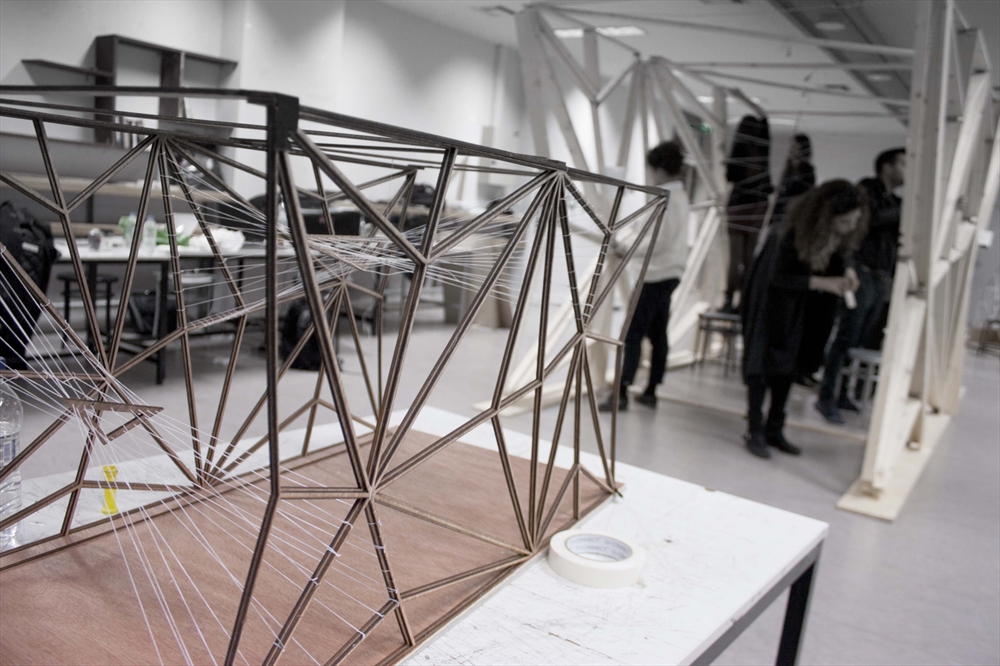 STRUCTURE ASSEMBLY VIA SCALED PROTOTYPE -PHOTO BY: ALICE MANGOYAN
STRUCTURE ASSEMBLY VIA SCALED PROTOTYPE -PHOTO BY: ALICE MANGOYAN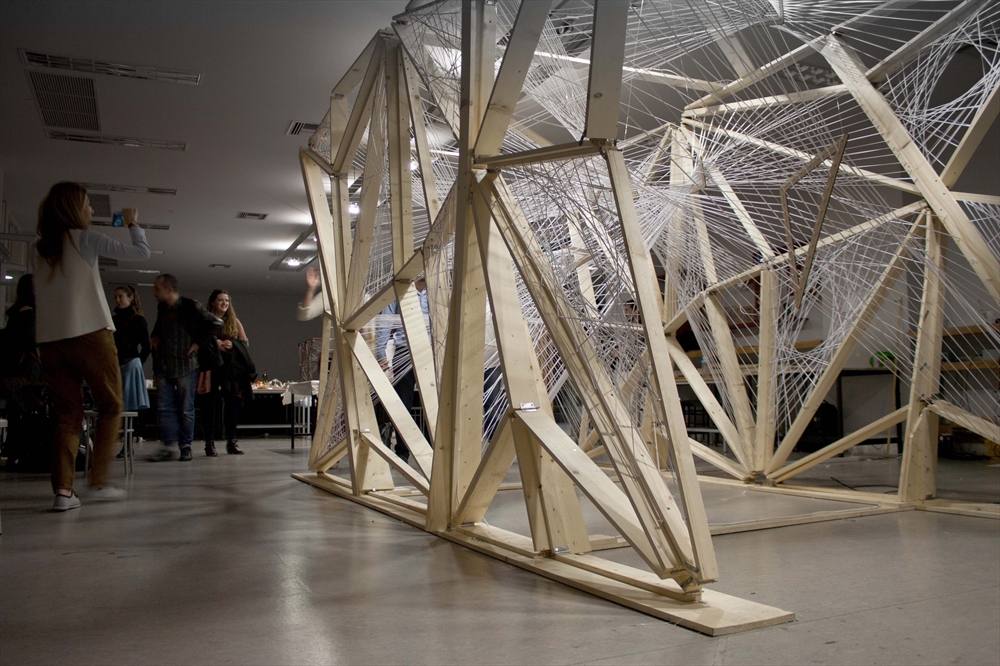 OVERVIEW OF THE INTERACTIVE/KINETIC ARCHETYPE -PHOTO BY: ALICE MANGOYAN
OVERVIEW OF THE INTERACTIVE/KINETIC ARCHETYPE -PHOTO BY: ALICE MANGOYAN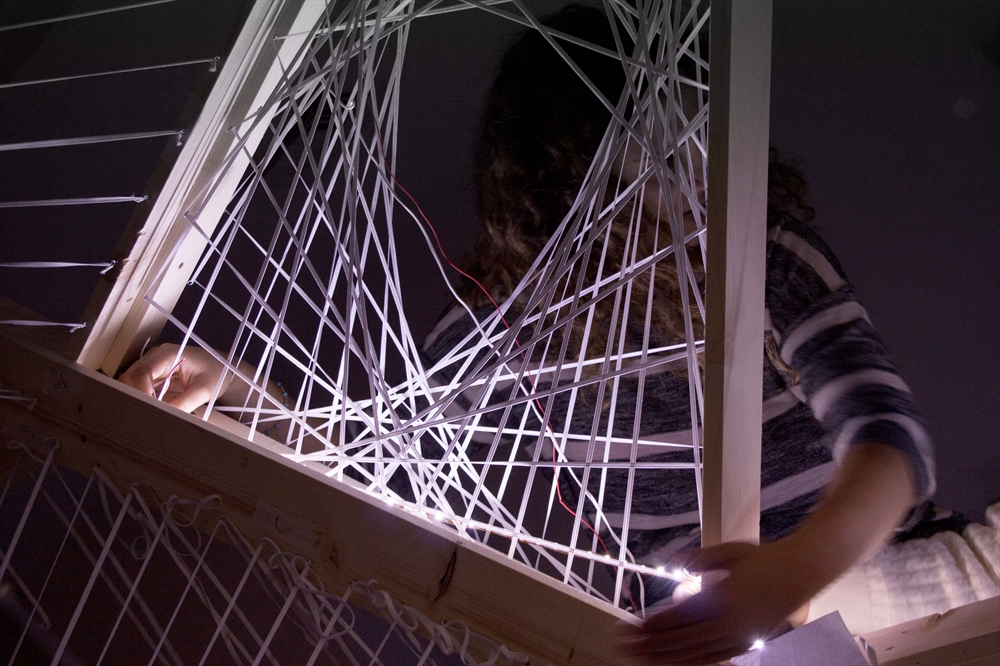 LIGHTING PATTERNED PANELING -PHOTO BY: ALICE MANGOYAN
LIGHTING PATTERNED PANELING -PHOTO BY: ALICE MANGOYAN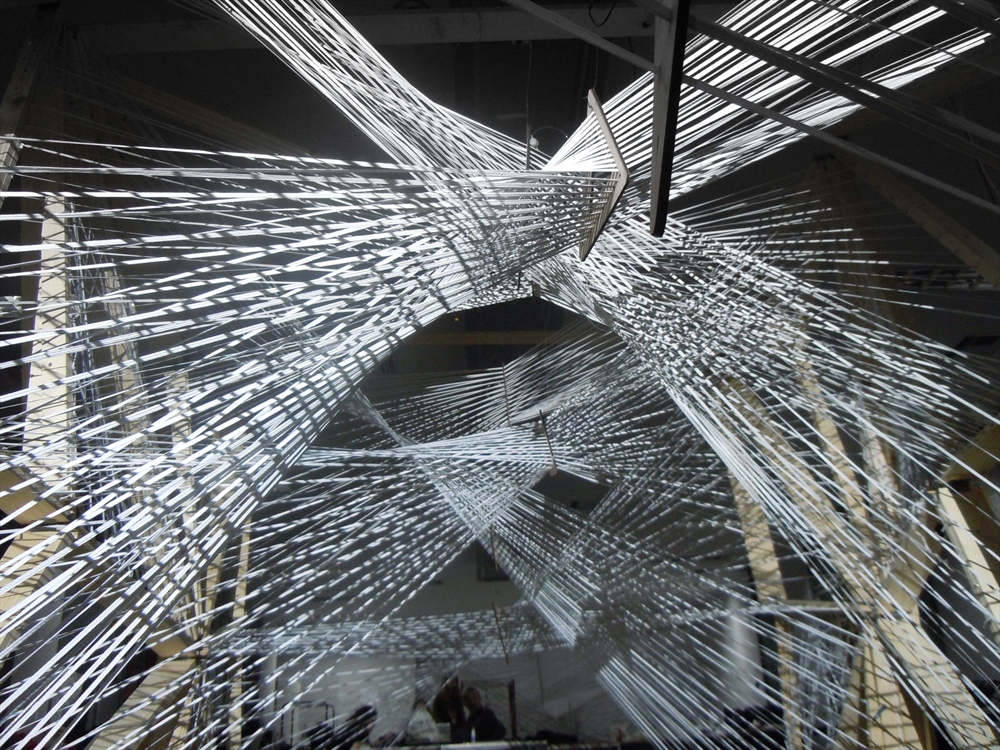 FIBROUS LIGHT PROJECTIONS. -PHOTO BY: ALEXANDROS KALLEGIAS
FIBROUS LIGHT PROJECTIONS. -PHOTO BY: ALEXANDROS KALLEGIASREAD ALSO: MATTER AND LIGHT IN BERLIN EXHIBITION ABOUT JOSEP FERRANDO'S ARCHITECTURAL WORK